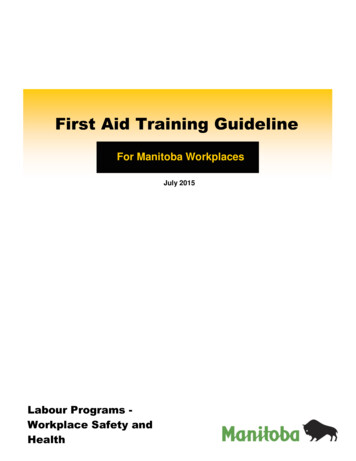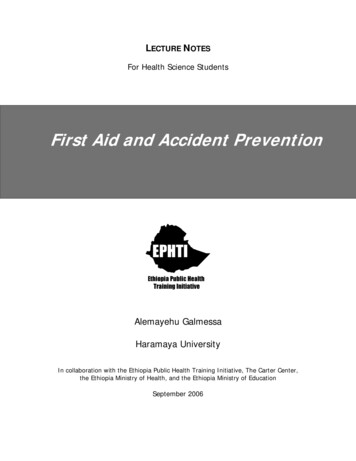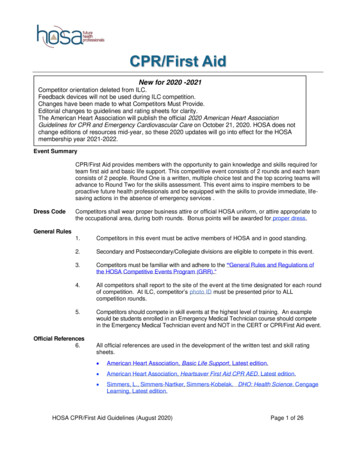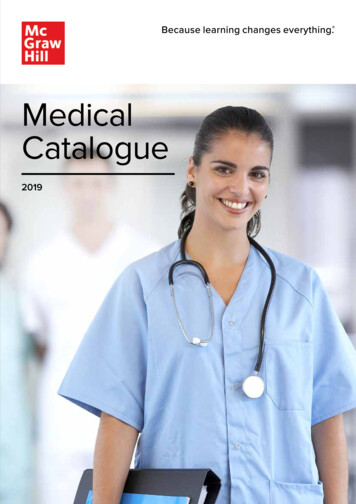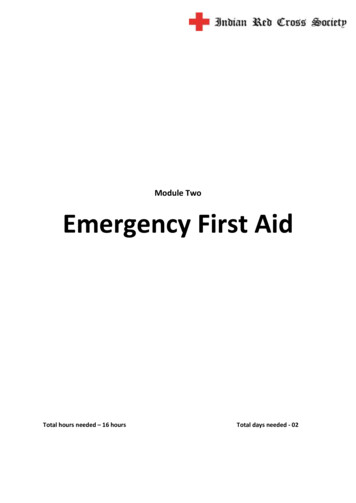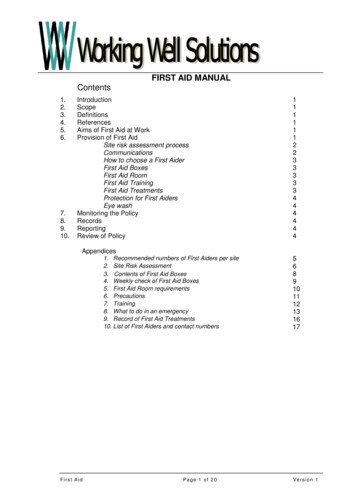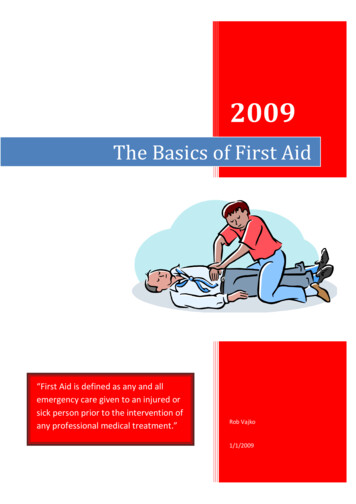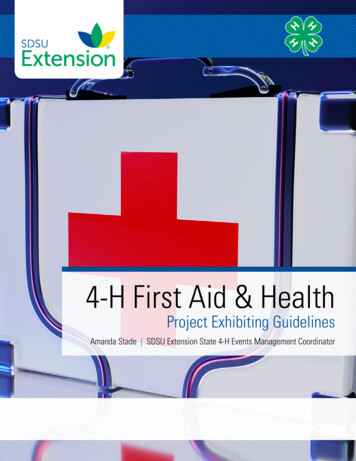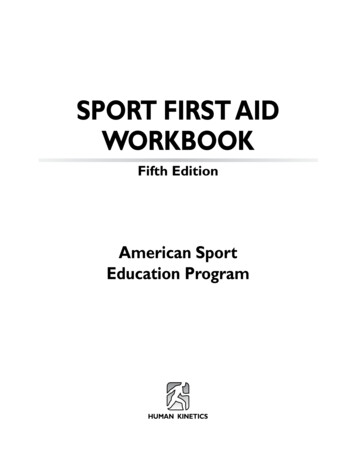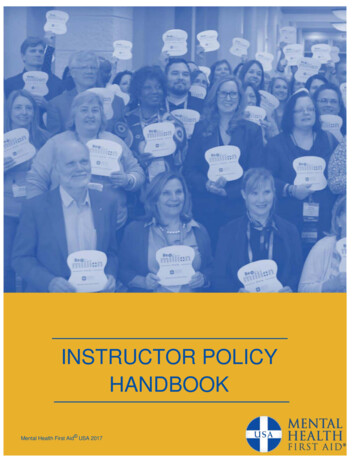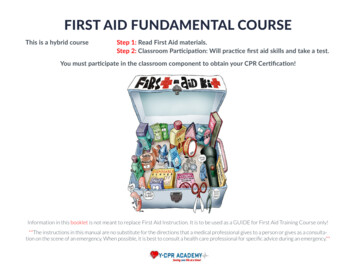
Transcription
FIRST AID FUNDAMENTAL COURSEThis is a hybrid courseStep 1: Read First Aid materials.Step 2: Classroom Participation: Will practice first aid skills and take a test.You must participate in the classroom component to obtain your CPR Certification!Information in this booklet is not meant to replace First Aid Instruction. It is to be used as a GUIDE for First Aid Training Course only!**The instructions in this manual are no substitute for the directions that a medical professional gives to a person or gives as a consultation on the scene of an emergency. When possible, it is best to consult a health care professional for specific advice during an emergency.**
CONTENTSGood Samaritan Law. . . . . . . . . . . . . . . . . . . . . . . . . . . . . . . . . . . . . . 1Nosebleeds. . . . . . . . . . . . . . . . . . . . . . . . . . . . . . . . . . . . . . . . . . . . 27Scene Safety. . . . . . . . . . . . . . . . . . . . . . . . . . . . . . . . . . . . . . . . . . . . . . 3Abdominal/Stomach Pain. . . . . . . . . . . . . . . . . . . . . . . . . . . . . . 28Body Substance Isolation (BSI). . . . . . . . . . . . . . . . . . . . . . . . . . . 4MEASLES. . . . . . . . . . . . . . . . . . . . . . . . . . . . . . . . . . . . . . . . . . . . . . 29Personal Protective Equipment (PPE) . . . . . . . . . . . . . . . . . . . . 5MEASLES. . . . . . . . . . . . . . . . . . . . . . . . . . . . . . . . . . . . . . . . . . . . . . 30Glove Removal. . . . . . . . . . . . . . . . . . . . . . . . . . . . . . . . . . . . . . . . . . . . 6WHOOPING COUGH . . . . . . . . . . . . . . . . . . . . . . . . . . . . . . . . 31When Calling 9-1-1. . . . . . . . . . . . . . . . . . . . . . . . . . . . . . . . . . . . . . . 7Emergency Contacts. . . . . . . . . . . . . . . . . . . . . . . . . . . . . . . . . . . . . . 8Consent for First Aid . . . . . . . . . . . . . . . . . . . . . . . . . . . . . . . . . . . . . 9First Aid Kits Y-CPR Suggestions. . . . . . . . . . . . . . . . . . . . . . . . 10START WITH THE HEAD. . . . . . . . . . . . . . . . . . . . . . . . . . . . . . . . 11START WITH THE HEAD (continued). . . . . . . . . . . . . . . . . . . 12Types of Medical Emergencies . . . . . . . . . . . . . . . . . . . . 13Passing Out & Fainting . . . . . . . . . . . . . . . . . . . . . . . . . . . . . . . . 14Allergic Reactions (Anaphylaxis). . . . . . . . . . . . . . . . . . . . . . . 15Diabetes & Low Blood Sugar . . . . . . . . . . . . . . . . . . . . . . . . . . 19Seizures . . . . . . . . . . . . . . . . . . . . . . . . . . . . . . . . . . . . . . . . . . . . . . . 20Asthma. . . . . . . . . . . . . . . . . . . . . . . . . . . . . . . . . . . . . . . . . . . . . . . . 21Asthma (continued). . . . . . . . . . . . . . . . . . . . . . . . . . . . . . . . . . . . 22Oral Injuries. . . . . . . . . . . . . . . . . . . . . . . . . . . . . . . . . . . . . . . . . . . 23Animal & Human Bites. . . . . . . . . . . . . . . . . . . . . . . . . . . . . . . . . 24Eye Injuries . . . . . . . . . . . . . . . . . . . . . . . . . . . . . . . . . . . . . . . . . . . 25Traumatic Injuries . . . . . . . . . . . . . . . . . . . . . . . . . . . . . . . 32Shock. . . . . . . . . . . . . . . . . . . . . . . . . . . . . . . . . . . . . . . . . . . . . . . . . . 33Bleeding. . . . . . . . . . . . . . . . . . . . . . . . . . . . . . . . . . . . . . . . . . . . . . . 35Bone Injuries . . . . . . . . . . . . . . . . . . . . . . . . . . . . . . . . . . . . . . . . . . 37Open (Compound) Fracture. . . . . . . . . . . . . . . . . . . . . . . . . . . 39Head & Spine injury . . . . . . . . . . . . . . . . . . . . . . . . . . . . . . . . . . . 40Concussions. . . . . . . . . . . . . . . . . . . . . . . . . . . . . . . . . . . . . . . . . . . 42Environmental Emergency. . . . . . . . . . . . . . . . . . . . . . . . 45Bug Bites. . . . . . . . . . . . . . . . . . . . . . . . . . . . . . . . . . . . . . . . . . . . . . 46Burns. . . . . . . . . . . . . . . . . . . . . . . . . . . . . . . . . . . . . . . . . . . . . . . . . . 47Heat Cramps & Heat Exhaustion. . . . . . . . . . . . . . . . . . . . . . 49Cold/Heat Emergencies. . . . . . . . . . . . . . . . . . . . . . . . . . . . . . . 51Poisoning Emergency. . . . . . . . . . . . . . . . . . . . . . . . . . . . . . . . . . 53Poisonous Plants . . . . . . . . . . . . . . . . . . . . . . . . . . . . . . . . . . . . . . 55Resources & References. . . . . . . . . . . . . . . . . . . . . . . . . . . . . . . 56
1GOOD SAMARITAN LAWWhat is the Good Samaritan Law?In Washington, according to RCW 4.24.300, a Good Samaritan is anyone who gives aid or assistance to anotherduring an emergency without expecting to be compensated for his or her actions and who is not considered to bea medical professional. To keep it simple: Good Samaritans are everyday people who help those who are injuredor unconscious and do not expect to be paid for their action(s). Though this is commendable of rescuers, thereare many concerns for those who help people in peril, such as will he or she be held liable for that person’s furtherinjury or death.These concerns are valid, but in Washington, there are laws set in place to protect citizens from liability whenthey are a rescuer so long as there is no willfully negligent or recklessness when rendering aid. Washington statealso has a 9-1-1 Good Samaritan Law whereby if a person seeks medical assistance for someone experiencing adrug-related overdose, he or she will not be charged with possession of a controlled substance.
2Consent to Medical Care and TreatmentI(the natural parent or legal guardian) hereby give permission that my,may be given emergency treatment to include first aid and CPRby a qualified staff member or I further authorize and consent to medical, surgical and hospital care, treatmentand procedures to be performed for my client or client(s) regular health care provider, or when that health careprovider cannot be reached, by a licensed health care provider or hospital when deemed immediately necessaryor advisable by the health care provider to safeguard my clients health and I cannot be contacted. I waive myright of informed consent to such treatment. I will be responsible for any emergency room or physician feesincurred. I also give permission for my client to be transported by ambulance or aid care to an emergency centerfor treatment.BirthdateAllergiesChronic IllnessesList of MedicationHealth Care Provider CareProvider's PhoneWho to contact in case of emergencyFather’s Work PhoneMother’s Work PhoneInsurance Company NamePolicy NumberPreferred HospitalHospitalSignatureIn an emergency, Paramedic will determine what hospitalPrint First & Last nameDATE
3SCENE SAFETYBefore administering First Aid or CPR, please make sure the Scene is Safe!Be aware of any surrounding danger.These are examples of hazards that could impact your ability to rChemicalEquipmentEnvironmentWeatherSmoke FireOther hazards include wet or slippery floors, broken glass, other sharpobjects, and body fluids.If you get hurt, you cannot help someone else.If you get hurt, who will help you?
4BODY SUBSTANCE ISOLATION (BSI)BSI is a method of infection control that assumes all body fluids are potentially infectious and that an effectivetask-specific barrier must always be placed between the medical provider and the patient.Body substances include urine, feces, blood, saliva, and vomit.
5PERSONAL PROTECTIVE EQUIPMENT (PPE)PPE refers to protective gloves, booties, clothing, helmets, goggles, or other garments or equipment designedto protect the wearer’s body from injury or infection. The hazards addressed by protective equipment includephysical, electrical, heat, chemicals, biohazards, and airborne particulate matter.
6GLOVE REMOVALProper Disposable Glove Removal videohttps://youtu.be/S4gyNAsPCbU
7WHEN CALLING 9-1-1 Know the location of the emergency. Describe the nature of the emergency. Tell the operator your name, address, and telephone number. Follow the dispatcher’s instructions. Do not hang up until the operator tells what to do next; they may have to ask more questions. Have good listening dBeSafe/GetReady/Calling911
8EMERGENCY CONTACTSYour Address isYour cross streetYour phone number you are calling fromYour First and last nameFireNeighborsPoliceDoctors #Dad cell phoneMom cell phoneDentistMedicationNotes
9CONSENT FOR FIRST AIDPermission from a conscious victim is required to avoid assault charges and termed consent. If the victim says NOto HELP stay with them until help has arrived.Permission from an unconscious victim is not obtainable from the victim. Therefore, we assume the victim wouldwant first aid. This action is termed implied consent, and you can help.
10FIRST AID KITS Y-CPR SUGGESTIONSFirst Aid Kit Contents List Only for Family MembersccccccccccccccccccccccccccAdhesive BandagesAntibiotic OintmentSterile GauzeCold CompressHydrocortisone OintmentCalamine LotionRubbing AlcoholHydrogen PeroxideHand Sanitizing GelSterile Saline SolutionSunscreen (at least SPF 15)Sunburn ReliefCotton BallsccccccccccccccccccccccccGlovesAce BandagesThermometerBulb SyringeTapeBlunt Tip ScissorsTweezersFine NeedlePlastic Bags All SizesAny Kind of Prescription ortals/1/Documents/Pubs/821-003 SupplyList LT.pdfFirst aid kit for Childcare Center WAC 170-295-5010
11START WITH THE HEADccBump, Bleeding, Swelling, BruisesThe Nose and Mouth forcc Breathing – qualitycc Odors – alcoholic and poisonouscc Blood and other fluidsThe Eyes forcc Pupils – equal and reactive to light (PEARL)cc Bruising around eyescc The Ears forcc Fluids – blood, etc.cc BruisesNeck and Base of Skull forcc Bumps, BruisesCollarbone and Shoulders forcc Bruises, Bumpscc Symmetry (with opposing side)Ribs for:cc Ability to expand and contract lungscc Bruises, Bumps, SymmetryAbdomen for:cc Rigidity, Bruising, Distensioncc Swelling, BruisingArms for:cc Bruises, Bumps, Symmetry
12START WITH THE HEAD (continued)Wrists for:cc Identification (bracelets or medical alert tags)cc Bruises, Bumps, SymmetryLegs for:cc Bruises, Bumps, Symmetrycc Range of Motion, Ability to MoveHands for:cc Bruises, Bumps, Symmetrycc Reaction to painToes for:cc Capillary reaction (return of blood when squeezed)cc Bruisescc Temperaturecc SwellingSpine for:cc Bruises, Bumps, SwellingPelvis for:cc Symmetrycc StabilityGroin For:cc Bladder controlcc BleedingFingers for:cc Return of blood to fingers after squeezing(capillary reaction)cc Bruises, Bumps, swellingcc Temperaturecc Colorcc MoistureFeet for:cc Reaction to Paincc Strengthcc Range of motioncc Identification (medical information)cc Symmetrycc Colorcc TemperatureDOTSDeformitiesOpen injuriesTendernessSwelling
13TYPES OF MEDICAL EMERGENCIES Fainting Allergic Reactions (Anaphylaxis) Epinephrine Pens Diabetes & Low Blood Sugar Seizures Asthma Attack Oral Injuries Eye Injuries Nose Bleed Measles Whooping Cough
14PASSING OUT & FAINTINGFainting is a brief and sudden loss of consciousness, generally due to a reduction in the blood flow to the brain.Typically, a faint results in a person falling to the floor.ccccFainting might have no medical significance. Or the cause can be a severe disorder, often involving the heart.Therefore, treat loss of consciousness as a medical emergency until the signs and symptoms are relieved, andthe cause is known.If you feel faint lie or sit down. To reduce the chance of fainting again, don’t get up too quickly.Sitting down and putting your head between your knees can facilitate the flow of blood to your brain. Remain insuch position for a couple of minutes until that feeling like you are about to pass out goes away on its own.If someone faints:ccPosition the person on their back. If there are no injuries and the person is breathing, raise the person’s legsabove heart level about 12 inches or above the heart if possible. Loosen belts, collars or other constrictiveclothing.To reduce the chance of fainting again, don’t get the person up too quickly. If theperson doesn’t regain consciousness within one minute, call 9-1-1 or your localemergency number.ccccCheck for breathing. If the person isn’t breathing, begin CPR and call 9-1-1.Continue CPR until help arrives, or the person begins to breathe.If the person was injured in a fall associated with a faint, treat bumps, bruises orcuts appropriately. Control bleeding with direct pressure.
15ALLERGIC REACTIONS (ANAPHYLAXIS)Allergy Triggers can be caused by foods, dust, plant, pollen, animal, dander, latex, mold insects, fragrances, medications, and chemicals.Students with known allergies should have an Individual Health Care Plan for taking medications and dealing withsymptoms and emergencies.
16ALLERGIC REACTIONS (continued)Allergic reactions can be mild or severe. However, some reactions that seem mild canbecome worse within minutes.Signs of mild and severe allergic reactions.ccccMild Allergic Reaction: A stuffy nose, sneezing, and itching around the eyes. Itchingof the skin (hives)Severe Allergic Reaction: Trouble breathing, Swelling of the tongue and face, signof shock.Anaphylactic Shock is a term for any combination of allergic symptoms that is rapid, orsudden, and potentially life-threatening. Time is critical; the victim is having a severereaction. Act quickly and call 9-1-1.If the person has a prescribed Epinephrine PenDepending on laws in your state and the level of training a first aid provider has, itmay be permissible for a first aid provider to administer an EpiPen to a victim ofanaphylaxis. The EpiPen must already be prescribed to the patient for it to be used.An EpiPen is an injection that contains Epinephrine, a chemical that narrows the bloodvessels and helps to open lung airways. It is also used after a severe insect bite or asting.
17ALLERGIC REACTIONS (continued)Administering the EpiPenccccccccccccccccRemove the safety capIf you are administering to a young child, hold the leg firmly in place while administering an injection.Place the orange tip against the middle of the outer thigh (upper leg) at a right angle (perpendicular) to thethigh.Swing and push the auto-injector firmly until it “clicks.” The click signals that the injection has started.Hold firmly in place for 3 seconds (count slowly 1, 2, 3).Remove the auto-injector from the thigh. The orange tip will extend to cover the needle. If the needle is stillvisible, do not attempt to reuse it.Massage the injection area for 10 seconds.Note the time of the injection. This is very important, as the EMS may want to know, so they can determine ifthey need to give another injection.
18ALLERGIC REACTIONS (continued)Never put your thumb, finger, or hand over the tip of the EpiPen; this is where the needle comes out. If accidentalinjected yourself and it is not your EpiPen, see medical attention right away.After Using the EpiPenLeave the safety cap off, this way, people will know it has been used.Put the EpiPen back inside the container and hand it to the EMS team for proper disposal.It may take several minutes before the medicine in the EpiPen begins to work.Anaphylaxis Emergency tion-Plan.pdfWatch the video on how to use an EpiPenhttps://www.youtube.com/watch?v EYyOqBXJeiw
19DIABETES & LOW BLOOD SUGARDiabetes is the body’s inability to make enough insulin. Insulin helps turn sugar into energy by allowing glucose to enterthe cell. If a person with diabetes does not eat enough sugar after an insulin injection, the sugar level in the blood drops.Low blood sugar causes the patient’s behavior to change.What Causes Low Blood Sugar?Someone who has not eaten.Someone who has given themselves too much insulin.Someone who has vomited.Use of medications, beta blockers, or certain antibiotics.Severe infection.Use of alcohol.Too much activity and not enough food for the amount of exercise.What to look for - Diabetic EmergencyIf you think someone has a diabetic emergency, you need to check against the symptoms listed below to decide iftheir blood sugar is too low (hypoglycemia). Confusion or irritabilitySleepiness or not responding Hunger, thirst or weaknessSweating, pale skin color Change in behavior
20SEIZURESSeizures are triggered by the excessive electrical activity within the brain that results in uncontrolled muscles convulsions throughout the body.Seizures happen without warning, the victim can lose control of their bowel or bladder and may vomit.DO NOT:ccccTry to restrain the person’s movements.Put anything in the victim’s mouth.DO: Call 9-1-1ccccccccccccccccMove away dangerous objects .Put soft padding like a pillow or a jacket under the victim’s head.Remove eyeglasses.Loosen tight clothing around the neck to ease breathing.Time the length of the seizure.Ensure the victim’s airway remains open by putting them inthe recovery position.Check for Medical jewelry.CALL 9-1-1 if the seizure lasts longer than five minutes.
21ASTHMAWhat is Asthma?Asthma is a medical condition that affects the airways – the tubes that carry air in and out of the lungs. Whensomeone has an asthma attack, these tubes become narrowed, making it difficult to breathe in and out.Examples of Asthma Triggers:Grass, smoke, pets, dust mites, mold, pollution, physical exercise, cold weather, high humidity, food.Signs and Symptoms of an Asthma Attack:Wheezing, difficulty breathing, and speaking, dry, persistent cough, fear or anxiety, gray-blue or ashen skin or changinglevels or responsiveness.
22ASTHMA (continued)Call 9-1-1ccccccccccccccGive the victim their medication if applicable.Remove the inhaler cap.Shake the inhaler several times.Connect the spacer (if needed).Help the victim place the inhaler or spacer end in theirmouth.Help the victim press the applicator with the medicationfor about 10 seconds.Use the inhaler again if needed.Action plan from the /lung/asthmaactplan.pdfListen to the Sounds of Asthmahttps://www.bing.com/videos/search?q Asthma Breath Sounds&&view detail&mid E2009C11B671DD82E723E2009C11B671DD82E723&rvsmid 411C79074FDFE
23ORAL INJURIESDental injuriesIf lips, teeth, or gums are bleeding or a tooth has been knocked out, you will want to apply direct pressure with asterile cloth to stop the bleeding. Children with a mouth injury that may have broken, loose, or knocked out teethcan be a choking hazard, especially for young children. If a toddler loses a baby tooth, there will be some blood,and this is normal.Steps After Losing a ToothccccccccApply pressure to stop the bleeding at the tooth socketRinse the tooth in water and put it in a cup of whole milkImmediately take the tooth to a dentist or emergency department.Hold the tooth by the crown, not the root (the part that was in the gums) if it wasa permanent tooth, there might be ligaments on the tooth that will help reattachit.If a tooth is avulsed or knocked out, make sure it is a permanent tooth (primary teeth should not be replanted).ccccccccKeep the person calm.Find the tooth and pick it up by the crown (the white part). Avoid touching the root.If the tooth is dirty, wash it briefly (10 seconds) under cold running water and reposition it. Try to encourage thepatient/parent to replant the tooth. Bite on a handkerchief to hold it in position.If this is not possible, place the tooth in a suitable storage medium, (e.g., a glass of milk or a special storagecontainer for avulsed teeth if available (e.g., Hanks balanced storage medium or saline). The tooth can also betransported in the mouth, keeping it between the molars and the inside of the cheek. If the patient is very young,he/she could swallow the tooth- therefore, it is advisable to get the patient to spit in a container and place thetooth in it. Avoid storage in water! Seek immediate emergency dental treatment.
24ANIMAL & HUMAN BITESAnimal and human bites may cause puncture wounds, cuts, scrapes, or crushing injuries.Most animal and human bites cause minor injuries, and home treatment is usually all that is needed to care for thewound.What to do if you have been bittenIf you have been bitten by an animal or another person:ccccccccccccClean the wound with large amounts of warm or room temperature water with soap. Wash wound for at least2 minutesControl Bleeding. If you cannot stop the bleeding, CALL 9-1-1Cover the wound with a sterile dressing and bandageSeek Medical attentionDo not try to catch the animal, but note its appearance and describe it to the medical professional.Watch for infection
25EYE INJURIESAny kind of injury or trauma to the eyes should be taken seriously.Prompt medical attention for eye problems can save your vision and prevent further complications. Eye injuriescan range from irritation to an object in the eye. Eye injuries may happen when a direct hit or punch to the eye orthe side of the head.Examples Of Eye InjuriesccccccccA ball or other object directly hits the eye.A high-speed object, such as a BB gun pellet hits the eye.A stick or other sharp object punctures the eye.A small object, such as a piece of dirt, gets in the eye.Signs/SymptomsccccPain redness, itching, swelling, burning,bleeding, debris, or a large object punctures the eye.
26EYE INJURIES (continued)Steps To Take After An Eye InjuryccccccDO NOT rub the eyes.Rinse the affected eye with water until debris is removed.If the debris is still in the eye cover both eyes and see medical attention.Chemical InjuriesccccccA chemical injury to the eye can be caused by a work-related accident or by common household products, suchas cleaning solutions, garden chemicals, solvents, or other types of chemicals. Fumes and aerosols can alsocause chemical burns.With acid burns, the haze on the cornea often clears, and there is a good chance of recovery.However, alkaline substances -- such as lime, lye, commercial drain cleaners, and sodium hydroxide found inrefrigeration equipment -- may cause permanent damage to the cornea. Damage may occur, even with prompttreatment. It is important to flush out the eye with clean water or salt water (saline) while seeking urgent medicalcare.Severe Eye Care If the object is in the eye, DO NOT remove, call 9-1-1.
27NOSEBLEEDSNosebleeds affect all ages but commonly occur in younger children and older adults.SignsccccBlood coming out of the nostrilsBlood might be dripping down the victim’s throat; this maycause the victim to get sick.Steps to Stop a Nosebleed:ccccccccccHave the person sit up straight with their head tilted forward.Pinch the nose right below the bridgePinch the nose for at least 10 minutesTell the victim to spit out any excess blood from their mouthIf bleeding doesn’t slow down, apply pressure directly abovethe upper lip.DO NOTccccccPut their head back as the victim may swallow a large amountof blood. You want to see how much blood they might belosing.Applying ice on the back of the neck is not effective.Stick gauze in the nose.
28ABDOMINAL/STOMACH PAINAdult SignsccccccccSudden, severe intolerable pain or awakening from sleep.Pain that begins in the general area of the central abdomen andlater moves to the right. Fever, sweating, black or bloody stools orblood in the urine.Pregnancy vaginal bleeding.Difficulty breathing or vomiting.Signs in Young ChildrenccccccccccPain that occurs suddenly stops and returns without warning.Pain accompanied by red or purple jelly-like stool or blood ormucus in stool.Greenish brown vomit.A swollen abdomen that feels hard.Hard lump in the lower abdomen.CALL 9-1-1
29MEASLESMeasles virus causes symptoms that can include fever, cough, runny nose, and red, watery eyes, commonlyfollowed by a rash that covers the whole body.Measles can lead to ear infections, diarrhea, and infection of the lungs (pneumonia)Symptoms. One of the most frustrating aspects of the measles virus for parents and caretakers is that, at first, itoften appears to be nothing serious. For about 1-5 days before the telltale rash appears, measles usually causessymptoms like those of a cold or flu. These early symptoms usually arise anywhere from 7–21 days after exposureto an infected person and include:ccccccccccccccccccccSore throatHacking coughSneezingRunny noseSwollen lymph nodesRed, runny eyesSensitivity to lightMore rarely, diarrheaGeneral malaiseNote: A person with measles can still spread the disease during this early stage
30MEASLESContact a doctor immediately if you or someone you know has measles. Because measles is highly contagious,it is important to notify your doctor as soon as you suspect you (or someone you know) has it. Although measles isnot responsive to antibiotics, your doctor still needs to diagnose your disease, monitor your symptoms, and mayeven need to treat secondary infections caused by the virus. Most treatment for measles itself is supportive — thatis, it’s designed to keep your symptoms manageable so that you can get better naturallyDon’t show up unannounced at your doctor’s office with a case of the measles. Always phone ahead. Becausemeasles is so contagious, your doctor may not want measles patients to be near the other patients, especially ifthey are very young or their immune systems are weakened. Your doctor may, for instance, advise you to use aseparate entrance or to wear a mask into the office.If a case of measles is confirmed, your doctor will notify the health department. The department will contact youdirectly to get more information since their goal is to track measles cases and prevent the virus from spreading.
31WHOOPING COUGHwhooping coughccCoughing persists for weeks to months.Fever is usually absent or minimal.A contagious bacterial infection that causes a range ofillnesses, from mild cough to severe diseaseccWho is most at risk for whooping cough?(those 12 months of age).The highest incidence is in infants, and they’re alsoat greatest risk for complications if they develop thedisease. In fact, the great majority of fatal cases in thecountry each year are in infants less than 6 months ofage, especially if they’re too young to have receivedtheir first vaccination.Infants younger than 6 months may develop complications and often require hospitalization.Signs or SymptomsccccccccccccSymptoms more severe in infantsHow is whooping cough treatedIt’s a bacterial infection, so it can be treated with antibiotics, usually erythromycin or a family of antibioticslike erythromycin. Erythromycin is taken for 2 weeksOver-the-counter cough medicines are not recommendedBegins with cold-like signs or symptoms.Coughing that may progress to severe coughing, and don’t really helpwhich may causeVomiting while coughingLoss of breath; difficulty catching breathCyanosis (ie, blueness)Whooping (ie, high-pitched crowing) sound wheninhaling after a period of coughing (may not occur invery young children).
32TRAUMATIC INJURIES Shock Bleeding Wound Care Tourniquets Broken Bones Sprains & Strains Head & Spine Injuries Concussions
33SHOCKShock is a life-threatening condition resulting in inadequate perfusion throughout the body and body system.Signs and symptoms of shock are any combinations of the following:Anxiety, restlessness, weakness, and/or dizzinesscc Decreased alertnesscc A rapid, weak pulsecc Cool, clammy skincc Rapid, shallow breathingcc Pale skin with bluish lips and fingernailscc Extreme thirst and dry mouthcc Fatiguecc Chest paincc Nausea and/or vomitingcc UnconsciousnessMake sure the victim is breathing, if not breathing start rescue breaths. Give 1 breath every 5 seconds, for two minutes.ccWHAT TO DOccccccccccccccMake sure the scene is safe.Call 9-1-1.Lie the person down on a flat surface.Elevate feet if nothing is broken 6-12 inches.If the person bleeds, vomits, or drools from his/her mouth, turn the head to the side to allow fluids to drain.Keep the person warm.DO NOT FEED OR ALLOW THEM TO DRINK ANYTHING.
34SHOCK (continued)ccccccccccSeptic shock results from bacteria multiplying in the blood and releasing toxins. Common causes of this arepneumonia, urinary tract infections, skin infections (cellulitis), intra-abdominal infections (such as a rupturedappendix), and meningitis.Anaphylactic shock is a type of severe hypersensitivity or allergic reaction. Causes include allergy to insectstings, medicines, or foods (nuts, berries, seafood), etc.Cardiogenic shock happens when the heart is damaged and unable to supply sufficient blood to the body. Thiscan be the end result of a heart attack or congestive heart failure.Hypovolemic shock is caused by severe blood and fluid loss, such as from traumatic bodily injury, which makesthe heart unable to pump enough blood to the body, or severe anemia where there is not enough blood to carryoxygen through the body.Neurogenic shock is caused by spinal cord injury, usually as a result of a traumatic accident or injuryWHAT TO DOccccccccccccccMake sure the scene is safe.Call 9-1-1.Lie the person down on a flat surface.Elevate feet if nothing is broken 6-12 inches.If the person bleeds, vomits, or drools from his/her mouth, turn the head to the side to allow fluids to drain.Keep the person warm.DO NOT FEED OR ALLOW THEM TO DRINK ANYTHING
35BLEEDINGIn General:ccccccCheck the scene and make sure it is safe. Call 9-1-1.Minimize contact with someone’s blood, exercise your PPE.Ask if you can help.Mild BleedingccccClean wound with room temperature water and pat dry.Add a sterile dressing on the wound.Severe bleeding, Call 9-1-1ccccccccAdd a sterile dressing.Apply pressure, if bleeding continues, apply more dressing and more pressure.Lift body limb above the heart.Treat for shock.Internal Bleeding, Call 9-1-1ccccA significant blow can create injury and bleeding inside the body. This is especially true for organs in the chestand abdomen. Internal bleeding
FIRST AID FUNDAMENTAL COURSE This is a hybrid course Step 1: Read First Aid materials. Step 2: Classroom Participation: Will practice first aid skills and take a test. You must participate in the classroom component to obtain your CPR Certification! Information in this booklet is not
